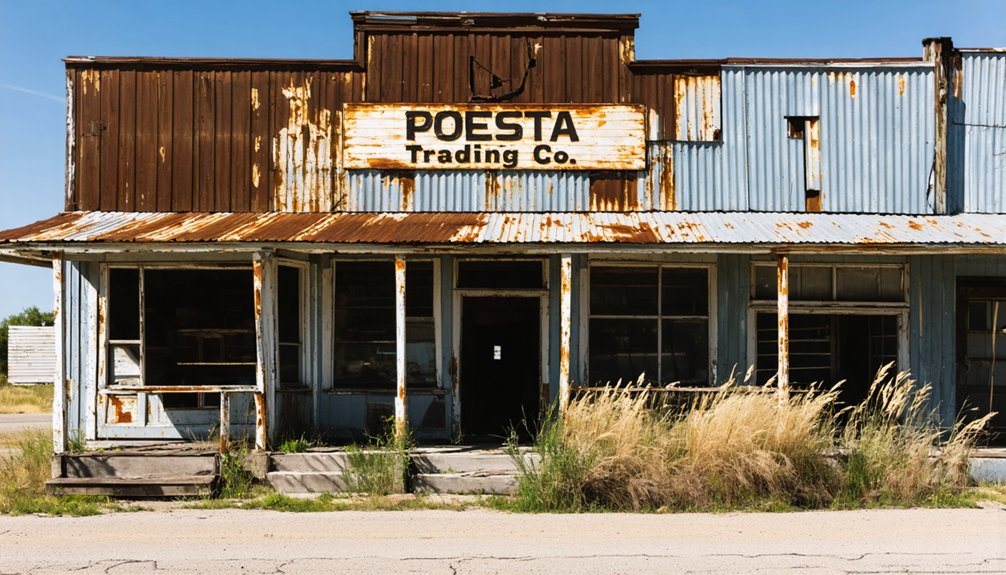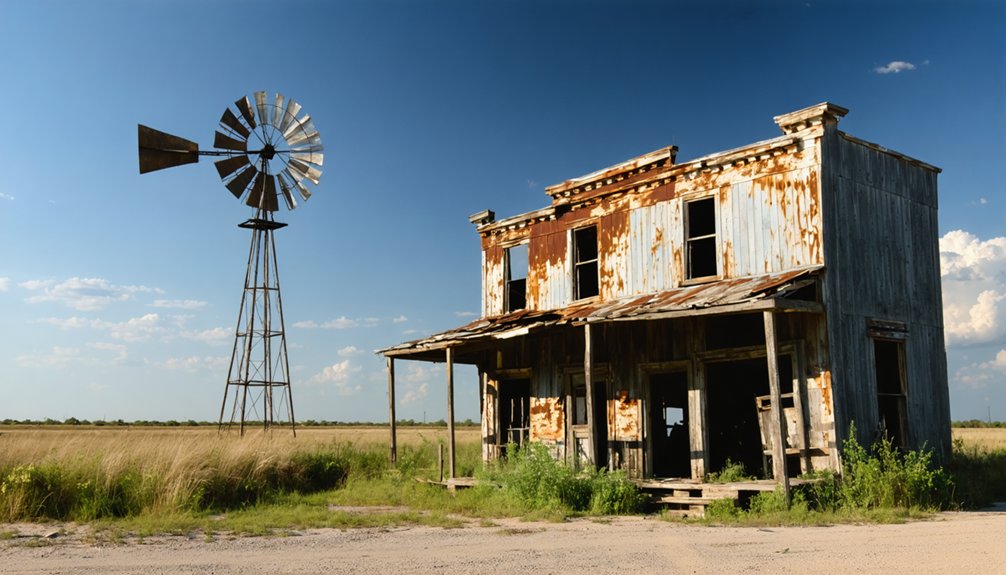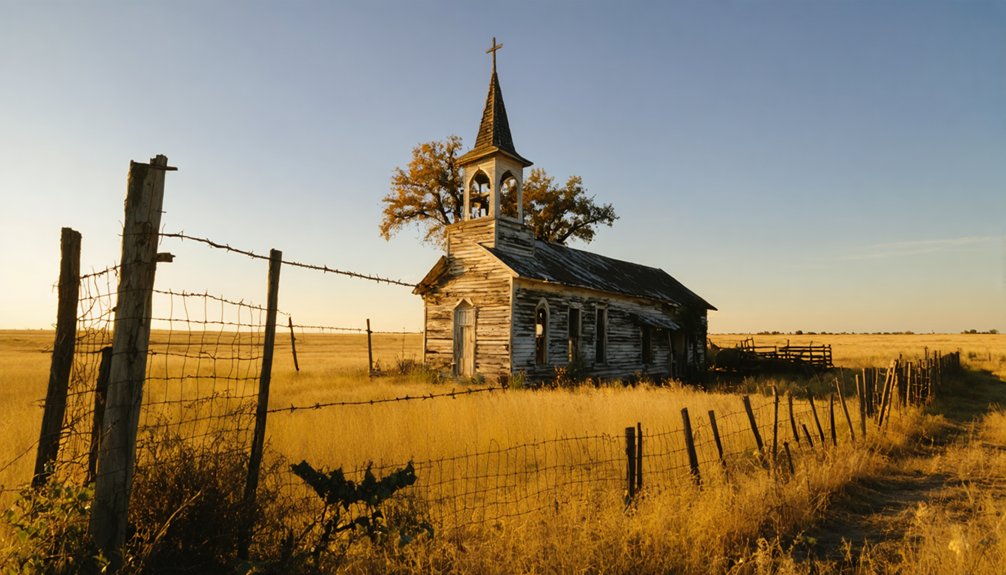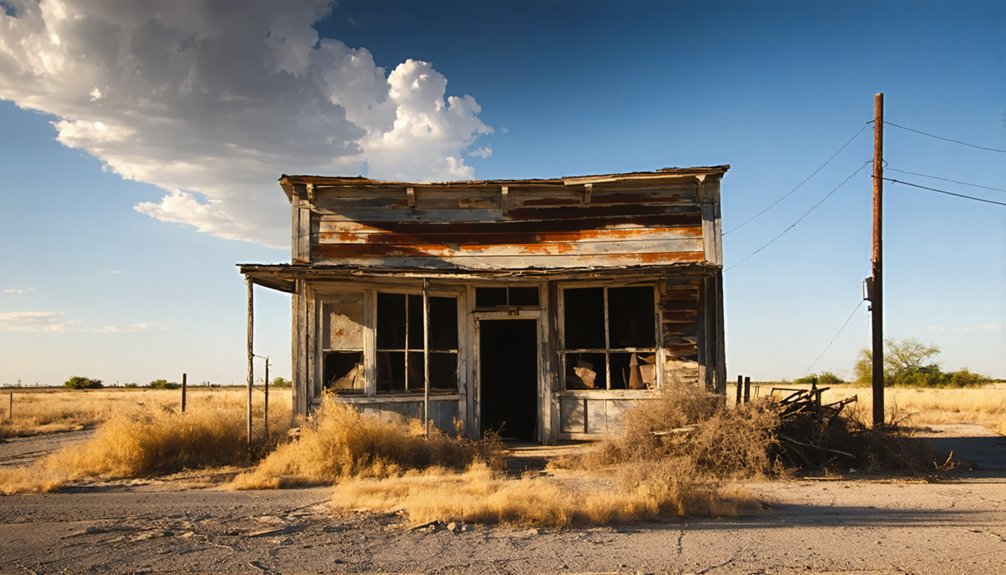You’ll find Poesta, Texas near Poesta Creek, established around 1890 as a mining and agricultural settlement. The town thrived briefly with railroad connections, attracting European immigrants and developing local commerce. After railroad companies rerouted lines away from Poesta, the town experienced rapid decline, with property values dropping 35% as residents left. Today, weathered Victorian structures and haunting local legends offer glimpses into this ghost town’s rich past and mysterious demise.
Key Takeaways
- Poesta was established around 1890 near Poesta Creek as a mining and agricultural settlement with strong railroad connections.
- The town’s decline began when railroad companies rerouted lines away, causing a 35% drop in property values and population exodus.
- Located in Texas’s Gulf Coast Plains, Poesta featured Victorian and early American architecture, including a general store and community church.
- Local legends include tales of ghostly children in the cemetery and supernatural occurrences along haunted roads near town.
- The ghost town currently lacks preservation efforts and faces ongoing deterioration of its remaining historical structures.
Origins and Early Settlement History
When settlers established the village of Hatcher’s around 1890, they chose a location near the essential water source of Poesta Creek.
You’ll find that this strategic positioning aligned with common settlement patterns of the era, as access to water proved vital for agriculture and daily life. Similar to how the post office became a mark of legitimacy for frontier towns like Ayr, the community soon changed its name to Poesta, reflecting its connection to the nearby creek.
The village’s commitment to growth became evident through the establishment of a local school, marking a significant educational impact on the area. Much like safe river crossings were crucial for early Texas settlements, Poesta Creek provided a reliable water passage for travelers and locals alike.
You can trace the community’s development through this period of westward expansion, as families built their homes and created a structured social environment. The school’s presence demonstrated the settlers’ determination to create a lasting, stable community in this part of Texas.
Geography and Natural Surroundings
You’ll find limited historical documentation about Poesta’s precise location within Texas, as this ghost town‘s geographical coordinates and boundaries remain uncertain in modern records.
The surrounding natural landscape likely shared characteristics with other West Texas settlements of the era, featuring semi-arid terrain typical of the region. Similar to Terlingua, the area may have experienced stable descending air that resulted in high sunshine levels throughout the year. Like many Texas ghost towns, Poesta faced natural disasters that likely impacted its development and ultimate decline.
While specific details about Poesta’s topography, water sources, and native flora aren’t preserved in available records, the area would have faced similar environmental conditions to other rural Texas communities of its time.
Location and Regional Setting
Although specific details about Poesta’s exact location remain limited in historical records, this Texas ghost town exists within the state’s diverse geographical landscape of plains, mountains, and desert regions.
Like many of Texas’s 511 ghost towns, Poesta’s regional setting likely played an important role in its development and eventual decline. Similar to the town of Old Bluffton, which was submerged under Lake Buchanan, natural forces could have impacted Poesta’s fate. You’ll find that local historical records are essential for understanding its precise location, as they’ve preserved whatever cultural significance remains of this abandoned settlement.
For ghost town tourism enthusiasts, Texas’s varied terrain offers unique perspectives on how natural surroundings influenced these lost communities. Remote locations, like the town of Styles situated 18 miles north of Big Lake, demonstrate the isolation that many of these settlements faced.
The state’s geography often determined the industries that flourished or failed in these areas, shaping the destinies of towns like Poesta through environmental challenges and economic opportunities.
Landscape and Natural Features
Located within Texas’s Gulf Coast Plains, Poesta’s natural landscape features a mix of clay and sandy soils that support patches of scrub brush and scattered trees.
You’ll find the terrain mostly flat with gentle hills, while the warm, humid climate shapes the coastal prairie ecosystem. Similar to Indianola, the town faced devastating hurricanes that reshaped its landscape over time. The region’s land use has evolved from historical agricultural practices, impacting soil conservation and wildlife habitats. Like many ghost towns in Texas, Poesta’s environmental conditions played a crucial role in its eventual decline.
Despite limited natural water sources, you can spot various wildlife, including deer and birds throughout the area. The nearby Guadalupe River and smaller streams influence the local hydrology, though water management remains vital.
The region faces ongoing environmental challenges, including soil erosion and the effects of climate change. Today’s conservation efforts focus on protecting these natural features while restoring native habitats and promoting sustainable practices.
Peak Years and Economic Growth
While mining defined Poesta’s primary economy, you’ll find that early settlers also attempted small-scale farming ventures around the town’s periphery.
Similar to Terlingua’s quicksilver mines, which dominated Texas mining in the early 1900s, Poesta’s extraction operations drove the local workforce and development.
The arrival of regional railroad networks helped transport mining products and brought increased commercial activity to Poesta’s businesses.
The town’s peak economic growth occurred when these agricultural efforts and railroad connections complemented the core mining operations of the Chisos Mining Company.
Like Thurber’s early days, the town attracted immigrant workers who came seeking opportunities in the mining industry.
Early Agriculture Ventures
During the early settlement years of Poesta, agricultural ventures transformed from basic subsistence farming into a thriving market-driven economy.
You’d find pioneering families working small homestead plots, growing staple grains while experimenting with cotton cultivation as market opportunities emerged.
Community agriculture flourished as farmers established support networks through local churches and schools. These institutions became essential hubs for sharing farming innovations and strengthening social bonds.
The fertile Central Texas soil and favorable climate patterns gave early settlers the natural advantages they needed to succeed.
As market demand grew, you’d see farms shifting from purely subsistence operations to profit-generating enterprises.
This change sparked the arrival of merchants and supply stores, creating a robust local economy that would later support Poesta’s peak cotton-producing years.
Railroad Development Influence
The arrival of railroad development in Texas marked a defining chapter for Poesta’s economic trajectory, building upon its agricultural foundation.
You’ll find that the railroad expansion throughout Texas, which grew from just 20 miles in 1853 to 17,000 miles by 1931, transformed communities like Poesta through enhanced connectivity and trade opportunities.
The economic implications were substantial for small Texas towns situated along rail lines.
You could see how these railways, built every 20 miles to accommodate steam locomotive water stops, created essential commercial lifelines.
Communities gained access to national markets, making the transportation of agricultural goods more efficient.
Poesta, like other railroad-connected settlements, would’ve benefited from the employment opportunities in railroad operations and related services that sustained local population growth.
Key Historical Events and Turning Points
As Poesta emerged in the late 19th century, several pivotal events shaped its trajectory from a small settlement into a bustling community. The discovery of valuable natural resources attracted immigrant workers from across Europe, bringing their unique traditions and skills that enriched the town’s cultural fabric.
You’ll find that Polish, Italian, British, and Irish influences became woven into Poesta’s identity through festivals and community gatherings.
The arrival of the railroad marked an essential turning point, connecting Poesta to major trade networks and spurring rapid economic growth. Local businesses flourished as the population swelled to several hundred residents.
The establishment of schools, churches, and fraternal organizations demonstrated the community’s commitment to permanence, while the expansion of postal services and transportation routes further strengthened Poesta’s regional significance.
The Decline and Abandonment

You’ll find that Poesta’s decline began when railroad companies rerouted their lines away from the town, cutting off crucial transportation access and commerce opportunities.
The town’s economic activities, including local businesses and agricultural operations, gradually ceased as residents lost access to broader markets and necessary services.
This triggered a steady population exodus, with families moving to larger towns and cities in search of jobs and better opportunities, ultimately leading to Poesta’s abandonment.
Railroads Bypass Town Growth
During Texas’s pivotal railroad expansion era, critical routing decisions dramatically shaped the fate of numerous small towns, with Poesta becoming a prime example of railroad bypass impacts.
Much like Helena’s infamous “Big Curve” reroute, you’ll find that Poesta’s isolation stemmed from similar strategic decisions by railroad companies that favored other locations. These choices often hinged on local politics and influential stakeholders rather than pure logistics.
When rail companies bypassed Poesta, they effectively cut off its lifeline to wider commerce and population growth.
You can see how this mirrors the pattern of many Texas towns that lost their chance at rail connectivity – their commercial infrastructure withered, younger residents moved away, and economic opportunities dwindled.
Without essential transportation links, Poesta couldn’t compete with rail-connected neighboring communities.
Economic Activities Cease Operations
Once Poesta’s oil and gas industry began scaling back production in the region, the town’s economic foundation crumbled rapidly.
You’d witness the devastating economic decline as businesses shuttered, property values plummeted by 35%, and unemployment soared. The community impact rippled through every sector, leaving behind a shell of what was once a thriving town.
The depth of Poesta’s downfall became evident through:
- Rental vacancies exceeding 20% while housing prices crashed and foreclosures jumped 40%
- Essential services vanishing as hospitals closed and schools shut down
- Local businesses failing as median household income stagnated around $46,000, far below Texas’s $73,000 average
Without economic diversification, you’ll find Poesta couldn’t recover as younger residents fled, leaving behind an aging population and deteriorating infrastructure.
Population Exodus Patterns Emerge
As major transportation routes shifted away from Poesta, a devastating population exodus began transforming the once-vibrant town into a shadow of its former self.
The transportation impacts rippled through every aspect of community life, as reduced accessibility led to job losses and diminished services. You would’ve witnessed families departing in waves as the town’s economic prospects dwindled.
The breakdown in community dynamics accelerated as crucial institutions closed their doors. Schools shut down due to declining enrollment, while the post office’s closure symbolized the town’s growing isolation.
Young residents sought opportunities elsewhere, leaving behind an aging population that couldn’t sustain local businesses. What began as a gradual outflow of residents eventually turned into a mass exodus, with the population dropping to mere single digits.
Notable Buildings and Structures

While little remains of Poesta’s original structures today, several notable buildings once stood as monuments to the town’s vibrant past. The architectural styles ranged from Victorian to early American, with surviving structures showing the town’s resourceful use of local materials like wood and stone.
You’ll find traces of Poesta’s former glory in:
- Commercial buildings, including a general store that served as the town’s economic hub
- Residential homes featuring rusty water pumps and weathered wooden porches
- A community church that anchored the town’s social life
Today, these abandoned structures stand in various states of decay, their peeling paint and crumbling foundations telling stories of a bygone era.
Weather and time have taken their toll, yet these silent sentinels continue to preserve fragments of Poesta’s history.
Life in Early Poesta
Beyond the weathered buildings that mark Poesta’s physical remains, the story of its early settlers reveals a determined community shaped by frontier life.
You’d find Irish and Mexican settlers working the land they’d acquired through Mexican land grants, transforming wild grasslands into what became known as a “stockman’s paradise.”
Community dynamics centered around Catholic gatherings, with traveling priests performing ceremonies in homes as early as 1848.
Survival strategies included hunting local game, growing vegetables, and maintaining essential trade connections despite slow supply lines from coastal ports.
You’d need to be resourceful to overcome the constant challenges – from wildlife threats and Native American conflicts to disease outbreaks and supply shortages.
Life demanded both self-reliance and strong neighborly bonds.
Local Legends and Stories

Through the whispers of generations, Poesta’s most enduring legacy lives on in its haunting local legends and supernatural tales.
These stories paint a vivid picture of frontier life, tragedy, and mystery in this Texas ghost town.
- Tales of ghostly children who perished in an epidemic haunt the local cemetery, where marked baby graves stand as silent witnesses to the community’s profound loss.
- A locked-away boy and a snake-catching hermit embody the isolation and hardship that defined life in early Poesta.
- Along haunted roads near town, you’ll hear stories of strange creatures and apparitions, including a half-goat, half-man entity that roams the darkness.
The town’s decline intertwines with legends of railroad revenge, while Sheriff Billy Dixon’s frontier heroism adds historical weight to the supernatural lore.
Visiting Poesta Today
Modern visitors seeking Poesta’s ghostly legends will find a stark contrast between the town’s rich folklore and its present-day reality.
Your ghost town exploration will reveal little more than open fields where buildings once stood, with nature having reclaimed most traces of this rural history.
You’ll need to rely on GPS coordinates to locate the site, as there’s no formal signage or visitor infrastructure.
Before venturing out, pack essential supplies like water and food – you won’t find amenities nearby.
Since much of the surrounding land is private property, you might need landowner permission for access.
Consider expanding your visit by exploring nearby Bee County attractions or following Poesta Creek’s path to better understand the landscape that shaped this vanished community.
Historical Preservation Efforts
Despite extensive documentation of Poesta’s historical significance, preservation efforts for this ghost town have remained minimal compared to other Texas sites like Shafter.
While preservation challenges persist, there’s no dedicated foundation or billionaire benefactor funding restoration projects here. Community engagement has been limited, with no formal plans for historical interpretation or structural rehabilitation.
Poesta’s crumbling structures stand forgotten, lacking the financial backing and community support needed to preserve its historic legacy.
To understand what’s missing at Poesta, consider these elements that successful Texas ghost town preservation typically includes:
- Dedicated nonprofit organizations securing funding and managing restoration
- Strategic plans balancing historical accuracy with modern safety requirements
- Active involvement of historical commissions and local stakeholders guiding preservation decisions
You’ll find Poesta’s historical structures continue deteriorating without the thorough preservation framework that’s helping revitalize other Texas ghost towns.
Frequently Asked Questions
What Animals or Wildlife Can Still Be Found Around Poesta Today?
Like watchful sentinels of the past, you’ll spot common Texas wildlife species including coyotes, white-tailed deer, and rabbits. Hawk and owl sightings are frequent, while javelinas roam the brushy areas.
Are There Any Living Descendants of Original Poesta Settlers?
You’ll find it’s challenging to confirm living descendants due to limited records, though some descendant stories may exist in local historical societies and family history collections across Texas.
What Did the Town’s Name “Poesta” Originally Mean or Reference?
You’ll find that despite popular claims, Poesta’s exact meaning remains uncertain – though Charles Goodnight believed it was an Indian word meaning “end of the trail,” its Spanish origin and historical significance remain debatable.
Were Any Movies or Television Shows Ever Filmed in Poesta?
You won’t find any film history or local legends about movies being made in Poesta – there’s no documented evidence of any television shows or films ever being produced at this location.
Has Anyone Reported Paranormal Activity or Ghost Sightings in Poesta?
You won’t find documented ghost stories or haunted locations specific to Poesta in mainstream sources, though nearby Texas ghost towns frequently report paranormal activity including shadowy figures and unexplained lights.
References
- https://www.youtube.com/watch?v=Zd8-gKw-5Hc
- https://www.hipcamp.com/journal/camping/texas-ghost-towns/
- https://mix941kmxj.com/the-strange-sad-story-of-a-texas-ghost-town-youll-never-visit/
- https://texashighways.com/travel-news/four-texas-ghost-towns/
- https://www.ghostsandgetaways.com/ghost-towns
- https://en.wikipedia.org/wiki/List_of_ghost_towns_in_Texas
- https://texashillcountry.com/3-great-texas-ghost-towns-investigate/
- https://www.texasescapes.com/Texas-Ghost-Towns-A-to-Z.htm
- https://mix931fm.com/texas-ghost-towns-history/
- https://kicks105.com/ghost-town-strange-name/



